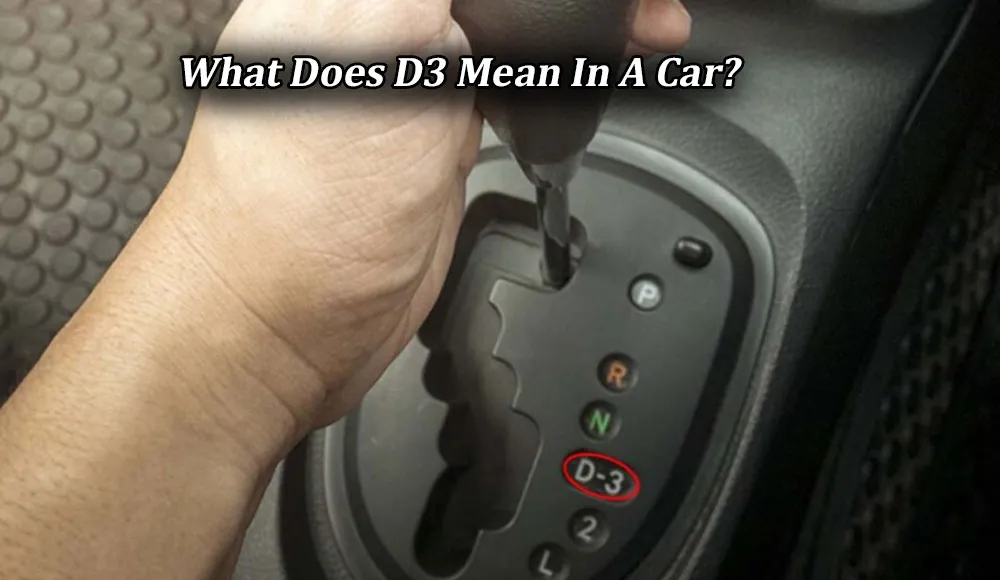Hello, fellow car enthusiasts and curious minds! Today, I’m excited to dive into a topic that often piques the interest of many drivers, especially those navigating the intricacies of automatic transmission vehicles. You might have seen this mysterious ‘D3’ on your gear shift and wondered, “What does this mean?” Well, let me take you on a journey through the gears and explain what D3 is all about.

Understanding the Basics of Car Transmission
The Role of Gear Modes in Automatic Cars
First things first, let’s talk about automatic transmissions. Unlike manual cars where you shift gears manually, automatic cars do the heavy lifting for you. But they still offer different gear modes for specific driving conditions. These modes typically include Park (P), Reverse (R), Neutral (N), Drive (D), and Low (L). Each mode serves a distinct purpose, and it’s crucial to understand them to make the most of your driving experience.
Differentiating Between Gear Modes
‘Drive’ is your standard mode for moving forward, but within this setting, you might notice options like D2, D3, or D4. These are sub-modes that offer more control over your car’s performance. Now, let’s zoom in on the star of today’s topic – D3.
Decoding D3 – Definition and Functionality
How Does D3 Work?
D3 stands for ‘Drive 3’, a specific setting in automatic transmission systems. When you select D3, your car limits itself to the first three gears. This might sound limiting, but it’s incredibly useful in certain situations. In essence, D3 provides more power and torque at lower speeds, which can be a boon in specific driving scenarios.
D3 vs. Other Drive Modes
In comparison to the regular Drive mode, which uses all available gears, D3 restricts the transmission, providing more control and response at lower speeds. This is different from D2 or L modes, which limit the car to even lower gears for more specific situations like steep inclines or towing.
The Advantages of Using D3 Mode
Ideal Situations for D3
One of the best times to use D3 is when you’re driving in hilly areas or need more power for climbing. It’s also handy in city traffic where you need quick acceleration after frequent stops. In these scenarios, D3 offers better control and can even contribute to more efficient fuel consumption, as your car isn’t constantly shifting to higher gears.
Performance and Control
In D3, your car responds more eagerly to the throttle, giving you that extra oomph when needed. This is especially useful when you need to overtake or merge onto highways. It’s like having a bit of manual control in an automatic setting.
Potential Risks and Precautions
When Not to Use D3
While D3 is beneficial, it’s not always the go-to mode. Using D3 at high speeds or for prolonged periods can strain your engine and transmission. It’s important to switch back to D or D4 for regular driving or when cruising at a steady high speed.
Safety Tips for Mode Switching
Always remember to switch modes only when the car is stationary or moving at very low speeds to avoid damage to the transmission. If in doubt, consult your vehicle’s manual, as each model may have specific instructions.
Real-World Applications of D3 Mode
Everyday Scenarios
I recall a time when I was driving through a mountainous region, and D3 was my best friend. It gave me the control I needed on steep roads without constantly braking. Many drivers also find it useful in stop-and-go traffic, as it provides quicker acceleration from a standstill.
Expert Opinions and Comparisons
Many driving experts agree that understanding and using D3 effectively can enhance your driving experience, especially in challenging terrains. It’s akin to having a semi-automatic feature, where you have a bit more say in how your car behaves.
Conclusion
To sum up, D3 is more than just another gear mode; it’s a tool that, when used correctly, can significantly improve your driving experience. It’s about having the right balance and knowing when to utilize this mode for optimal performance and efficiency. Always remember, the more you know about your car, the better and safer your driving experience will be. So next time you see that D3 on your gear shift, you’ll know exactly what it’s there for!
